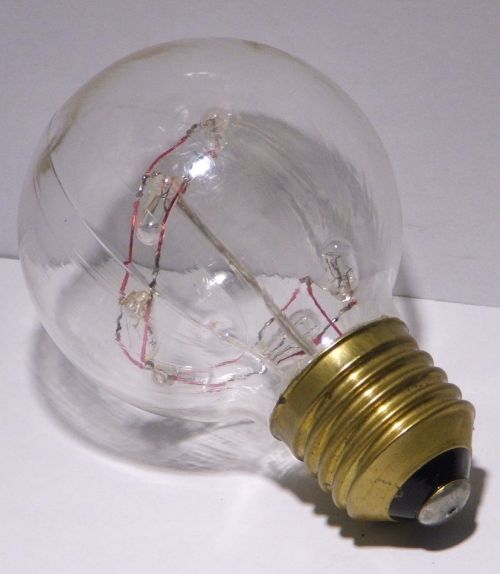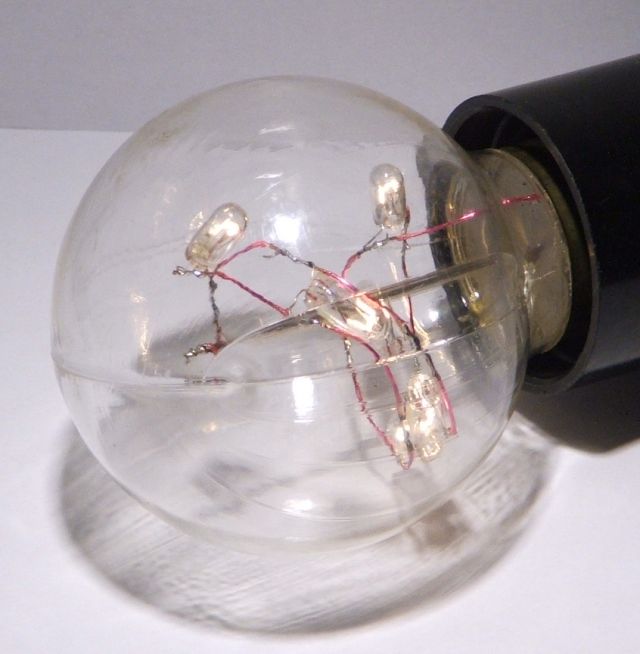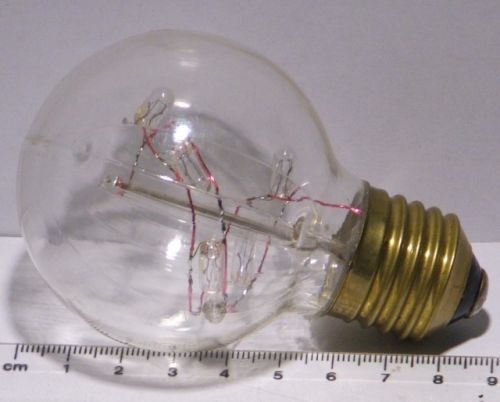
| Manufacturer: | Lightgraphix UK |
| Model: | -- |
| Application: | Decorative |
| Wattage: | 5.7W |
| Diameter (max): | 60mm (G60) |
| Length: | 90mm |
| Tube Length: | N/A |
| Bulb/Tube material: | Outer: Plastic. Inner: Glass |
| Colour Temperature: | Not Stated - Estimate around 2000°K |
| Peak output wavelength: | N/A - Broadband emission |
| Total light output: | Unknown |
| Rated lifetime: | Not Stated |
| Cap: | E27 |
| Operating voltage: | 12V AC/DC |
| Operating current: | 480mA |
| Warmup/restrike time: | N/A |
| Cost (original): | Unknown |
| Place of manufacture: | Dartford, United Kingdom |
| Date of manufacture: | Unknown |
| Lamp Status: | Working |
This is one of the more unusual lamps in my collection. This is a lamp created by a UK based company who specialise in the manufacture of customised lighting solutions. 24V and 240V versions of this lamp are stocked, but the 12V version seen here was made to order only. This specific lamp was one of a number bought to illuminate a contemporary chandelier in a night club. Only a very low lighting level was actually required, the main aim here being to create a sparkling effect. In this case it was run on around 10V, this would have meant that the tiny vacuum incandescent lamps used here would last a long, long time indeed.
The lamp is of a rather unusual construction. The outer bulb is a custom moulded affair made of a fairly sturdy plastic - the appearance doesn't appear to have been given much thought, as the moulding marks are very clearly visible. Internally things are even more unusual; with a single plastic sheathed wire protruding into the bulb from the tip of the cap. This is the main support for the rest of the hardware. The rest of this hardware consists of six tiny little 12V 1W capless incandescent lamps (the kind used for the likes of car dashboard illumination before LEDs and Electroluminescent panels became commonplace), wired in parallel. These are suspended inside the bulb by what appears to be enamelled cable with the tiny leads from each lamp soldered to these two pieces of wire. The other one (the one not connected to the centre support) disappears down into the lamp cap, presumed to be attached to the cap's shell. The "stem" area is sealed with what looks to be silicone type sealant.
The parts themselves wouldn't have cost much (assuming the bulb itself wasn't something custom made for the purpose anyway), but it would have taken a fair while to put together - this appears to have been a hand built product. It's probably not worth a huge amount - but I think as a collector it has to have a pretty special place in here simply through the fact that it's so weird, and that it's been assembled by someone - rather than a machine.

Lightgraphix UK Custom Made Decorative Low Voltage Lamp - general overview of lamp

Lightgraphix UK Custom Made Decorative Low Voltage Lamp - Showing cap and rear of lamp

Lightgraphix UK Custom Made Decorative Low Voltage Lamp - Lamp shown while alight

Lightgraphix UK Custom Made Decorative Low Voltage Lamp - Showing size of lamp

This page last updated:
17th June 2023: Changes to page format to improve readability on mobile devices, also some background code changes to improve search engine performance.